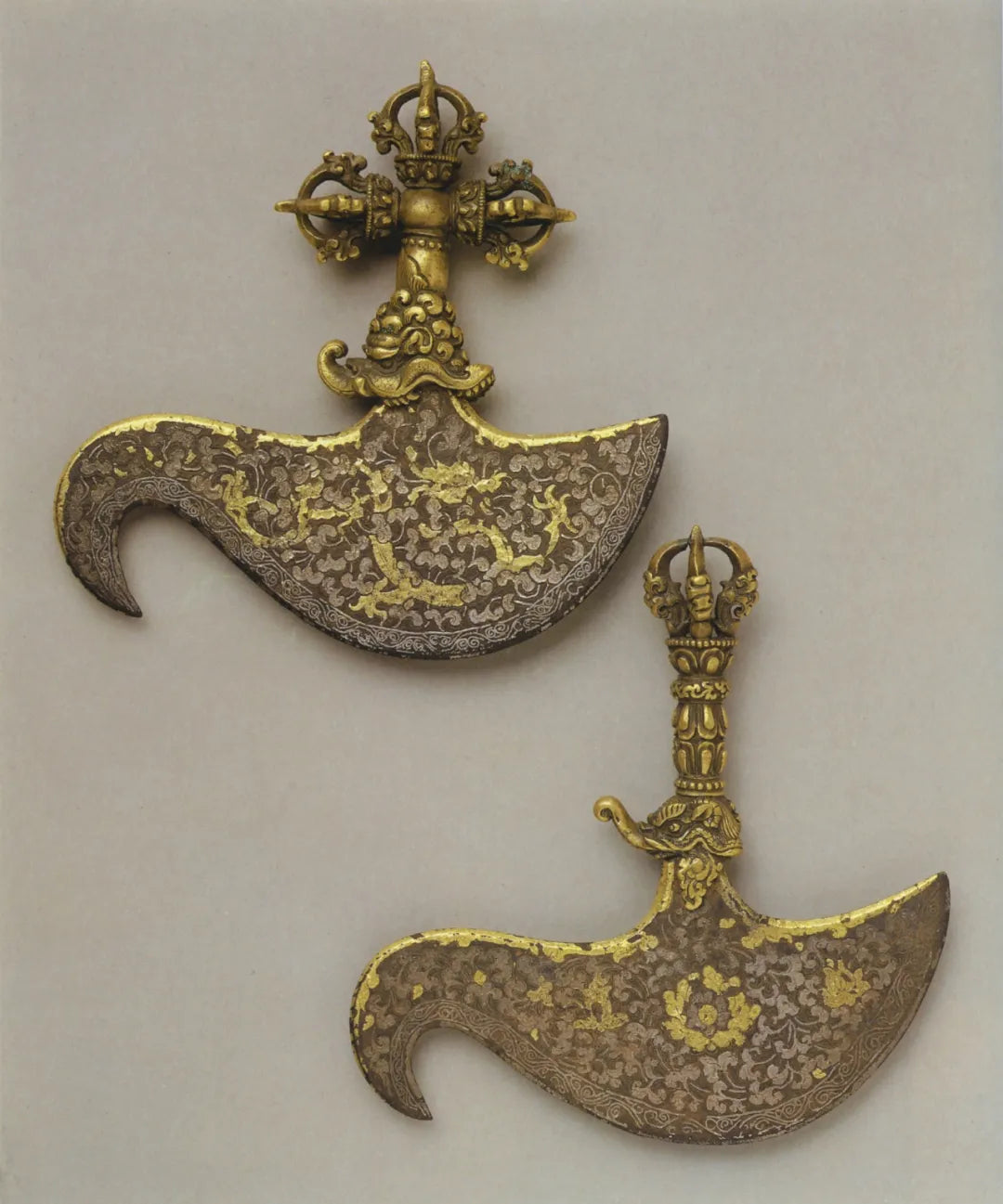"Single blade Vajra Kartika"
Eighteenth century, housed in the British Museum

"Vajra Kartika of mantra"
15th century, private collection
The mantra inscription on the blade.
When the great master Atisha brought the deity Mahakala, the Holder of the Trident (མགོན་པོ་གྲི་གུག་), holding a vajra chopper knife, into Tibet, many sects considered him as one of the central deities. There are some differences in the texts when describing the functions and symbolism of the vajra chopper knife. In the ritual texts of the First Gendun Zhuab (དགེ་འདུན་གྲུབ་པ་; 1391-1474), the vajra chopper knife is mainly seen as a weapon to destroy demonic enemies and vow breakers, as well as a symbol of cutting off attachment to all phenomena. Different actions using the vajra chopper knife are described, such as swinging it upwards symbolizing conquering and cutting through ego attachment. In addition to writing ritual texts concerning the Holder of the Trident, Gendun Zhuab also criticized a common occurrence at the time where people would confuse similar looking ritual instruments (especially vajra chopper knives). It is important to note that this mistake still happens today, such as mistaking a battle axe for a longer chopper knife.

"Holding the Scepter, Arrogant Ruler"
18th century, in the collection of the Ruben Museum of Art in New York
The Vajra Kartika in the image above.
The venerable Radun Juba in the image above.
Today, people often simply regard the paring knife as a type of ancient weapon from South Asia, but this is a rather one-sided conclusion. In the textual context of South Asia, Kartika (कर्त्री;གྲི་གུག་) typically appears in three relatively distinct contexts. Firstly, the Kartika is used as a tool to cut offerings during specific rituals, emphasizing the notion and practice of "devotion". Secondly, the Kartika is used to handle corpses during funerals, with its purifying function being symbolized in later esoteric traditions (such as in the charnel ground landscape). Lastly, the Kartika is a tool used to eliminate enemies and subdue living beings, although descriptions of direct combat using the paring knife are scarce. In these three contexts, the paring knife has four interchangeable methods of use - cutting, hooking, picking, and stripping (each with its own connotations). When these four methods are combined, they represent a "creative subject consciousness". It is precisely because of these various methods of use that the paring knife is often seen as a component of other weapons (or ceremonial instruments).

"The Mother of Time"
End of the 19th century, in the collection of the Metropolitan Museum of Art
As the incarnation of the Supreme Snow Mountain Goddess,
Shi Mu held a special sacrificial sword in her right hand,
This sword once beheaded the water buffalo demon,
Shi Mu's sacrificial sword is one of the origins of various tantric implements,
including the axe and short blade.
"The Forest Retinue"
Mid-nineteenth century, housed in the British Museum.
The young girl in the "Buza family" (པུ་ཏྲ་མིང་སྲིང་) is one of the five attendants of
the Puzhang master. In her right hand, she holds a short-bladed
weapon (क्षुर;སྤུ་གྲི་) and not a crescent-shaped axe as is often mistaken.
In general, people consider the Vajra, Phurba(ཁ་ཊ་ཀ་), and Kapala(ཐོད་པ་) as the three main spiritual symbols(གྲི་ཐོད་དང་ཁ་ཊྭཱཾ་) of female deities (or practitioners). Holding these three ritual objects, the Vajra represents wisdom, the Kapala represents method, and the Phurba symbolizes the integration of wisdom and method. When facing dangers from hostile spirits and the defilements of ego, the deities use these objects to strip away their outer layers and pick out their "flesh" (symbolizing skillful means) into the Kapala. In this way, practitioners can imagine the process of placing their wisdom in a container. When the Vajra performs the "cutting" practice, all obstacles to spiritual progress can be eliminated, such as afflictions and the dualistic obstacles of knowledge(ཉོན་མོངས་སྒྲིབ་) and delusion(ཤེས་བྱ་སྒྲིབ་). In the rituals of the Sakya tradition, the essence of the Vajra lies in cutting through afflictions, cultivating non-dualistic wisdom, and realizing the inseparability of wisdom and skillful means.

"Vajravarahi"
Late 18th century, in the collection of the Rubin Museum in New York
The Bodhisattva swung the jade-edged sword downward,
completely severing the source of cyclic existence,
undertaking the majestic task of unimpeded action.
"Lion-Faced Dakini"
Mid-19th century, Zanabazar Fine Arts Museum
The lion-faced dakini holds a vajra chopper knife, able to dispel the four
obstacles obstructing the right path: desire, external obstacles,
hearers of the lesser vehicle, and solitary realizers of the lesser vehicle.

"The Selfless Buddha Mother"
Mid-16th century, private collection
The Vajra Knife of the selfless Buddha Mother is placed on the skull cup,
symbolizing the union of feminine wisdom and compassionate heart
capable of breaking through the three obstacles hindering practice:
the obstacle of desire, the obstacle of aversion, and the obstacle of ignorance.
















